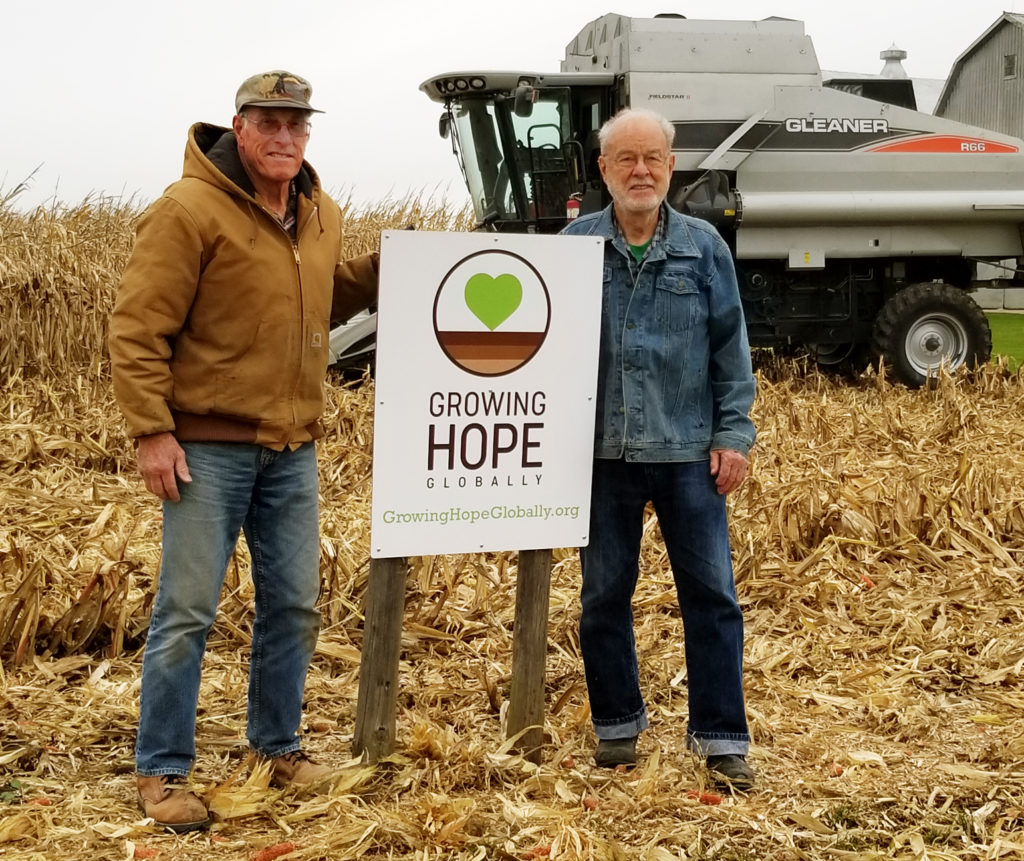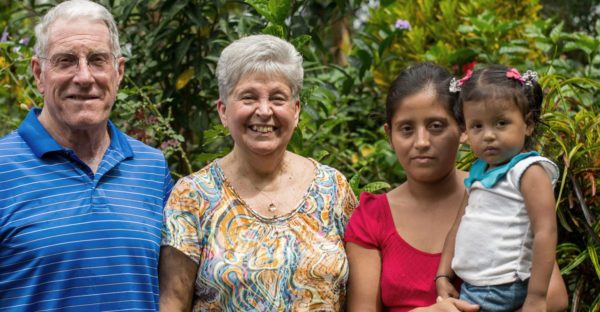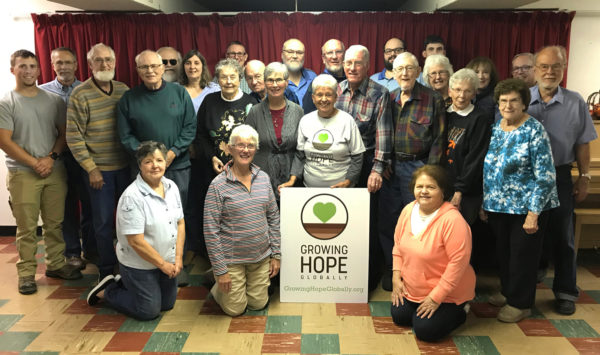
How one Illinois farm community feeds another in Nicaragua
This article was originally published in Prairie Farmer.
By Rick Moser
For 15 years, farmers near Polo have used their harvest proceeds to help farmers around the world raise more food. Jim Schmidt (left) and Bill Hare started the Growing Project in Polo in 2004. Here’s how it works.
What if you could make a difference for farmers around the world who are struggling to feed their families — right from where you live and farm? That’s what Growing Hope Globally allows an entire agricultural community around Polo, Ill., to do.
The endeavor started 20 years ago when two Ohio farmers wanted to help feed hungry people. Carol Sloan and her late husband, Vernon, worked with their neighbors from Stryker, Ohio, to harvest, bag and ship corn around the world. When shipping costs rose, they asked their church denomination for help. They ultimately founded Growing Hope Globally, a Christian-based response to address hunger, which now operates in more than 30 countries.
Over the past 20 years, Growing Hope Globally has helped 2 million people increase yields, improve health, build communities, and break the cycle of hunger and poverty. People everywhere want the dignity of providing for themselves, so the Growing Hope model provides a hand up, not a handout. To date, Illinois farmers have contributed more than $5.3 million to Growing Hope.
Polo’s Growing Project
In a typical Growing Project, farmers contribute a portion of their land, equipment and time, while churches and civic groups raise money for seed, fertilizer and other inputs. When the crop is sold, the proceeds are given to Growing Hope Globally, and the Growing Project volunteers choose a specific program overseas to fund. There are currently 161 Growing Projects in rural communities across the U.S., including 21 in Illinois.
Bill Hare and Jim Schmidt started the Growing Project in Polo in 2004. They liked the idea of setting aside ground and using the proceeds to reduce hunger and poverty around the world, and they set aside 20 acres to grow and harvest the first year. In 2019, they harvested 30 acres of corn for their Growing Project.
“It’s not a lot of work, and I’m glad to be able to do it,” Jim says. The pair built on their community relationships, recruiting monetary support from churches and local agribusinesses, which donate seed and fertilizer. Their local elevator even adds 10 to 20 cents per bushel to the sale price of the Growing Project harvest.
But is it worth it?
“What worthwhile project is not worth the effort?” Bill asks. “I cannot imagine being a parent and having no money, no food, no government program to assist you, and my kids coming to me and saying ‘Daddy, I’m hungry.’ We’re making a real difference for the people in these programs.”
Growing Food in Nicaragua
Jim and his wife, Karen, have visited programs in Nicaragua implemented by Growing Hope’s partners, and met with people who participated in the Nicaragua Matagalpa Program.
“We were able to see the contrast between those who participated in the program and those who had not,” Karen says. “I was amazed to see what the program had accomplished in such a short period of time.”

“They were elated!” Jim says of the participants, sharing how they are able to raise their own food and can afford to send their kids to school. One young mother is growing a vegetable garden next to her home. She now has plenty of food for her child and can share with others — and she doesn’t have to go to town to work every day and be separated from her child.
“If you have any doubts about Growing Hope, find a few people who are interested in getting involved and go visit an overseas program,” Jim says.
Karen was also struck by the participants’ willingness to share with their neighbors — not just the food but also what they’ve been taught.
“It’s not just about growing hope for one family; it just keeps growing and growing and impacts the entire community,” she says. “To see the faces of the people — to look into their eyes and see the hope and joy — there is no doubt in my mind that these programs are working.”
Bill observes that neighboring communities see the improvement and want to get involved. “It’s also good to see how the money goes right to the people who are teaching others.”
What is it like to farm in Nicaragua?
“Smallholder farmers in Nicaragua face many challenges, some familiar to us and some unique. Changing weather patterns is the most pressing issue,” says Alex Morse, associate regional director for Growing Hope Globally.
Precipitation levels are similar to years past, but rains arrive over two to three days as opposed to being evenly distributed across the growing season. This stresses plants, floods fields, creates prolonged dry periods, and nurtures disease and insect pressures. Most farmers have access to 1 to 2 acres of land, so maximizing yields is critical. Corn averages 15 bushels per acre.
Working through local partners in Nicaragua, Growing Hope supports training programs that help farmers improve yields and income. Training on conservation agriculture builds organic material into the soils and helps the ground retain more moisture after rains. Crop diversification training introduces farmers to crops that are better suited for extreme wet or dry conditions. Bananas provide more shade for the soil and are drought tolerant, while crops like taro root are more tolerant to standing water. Adding a cacao (chocolate) crop helps provide more consistent income throughout the year.
Volunteers for the Polo Growing Project recently celebrated their 15th year of Growing Hope at the annual Harvest Celebration, held at Church of the Brethren, Polo. Thanks to farmers like this, Growing Hope funds training programs for farmers in developing countries, so they can increase yields, provide for their families, and break the cycle of hunger and poverty.
How far does Polo’s Growing Project reach?
Founded by: Jim Schmidt and Bill Hare
Year founded: 2004
Number of people impacted to date: 8,430
Funds raised for Growing Hope to date: $463,637
Programs currently funding: Honduras Comayagua, Honduras Macuelizo
Churches involved: Church of the Brethren, Polo; Dixon Church of the Brethren, Dixon; Highland Avenue Church of the Brethren, Elgin; Faith United Presbyterian Church, Tinley Park
Moser is associate communications director with Growing Hope Globally. For more information on how to get involved with Growing Hope in Illinois, contact Regional Director Eric Mattson at eric@growinghopeglobally.

